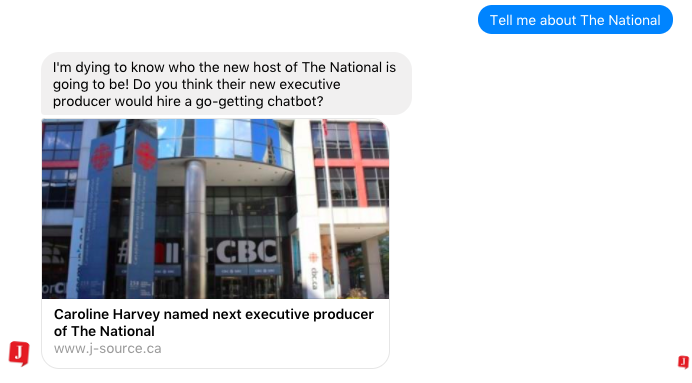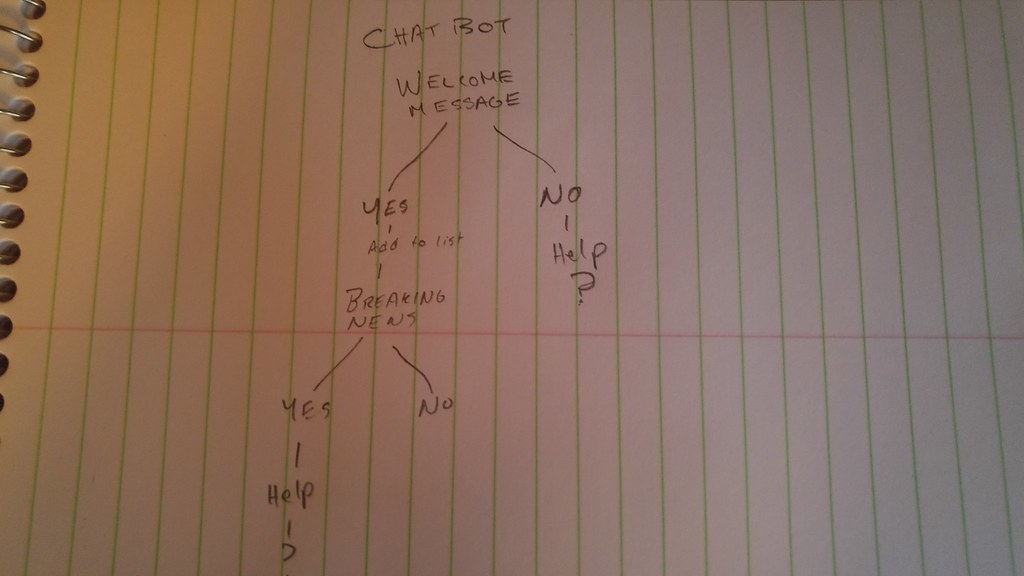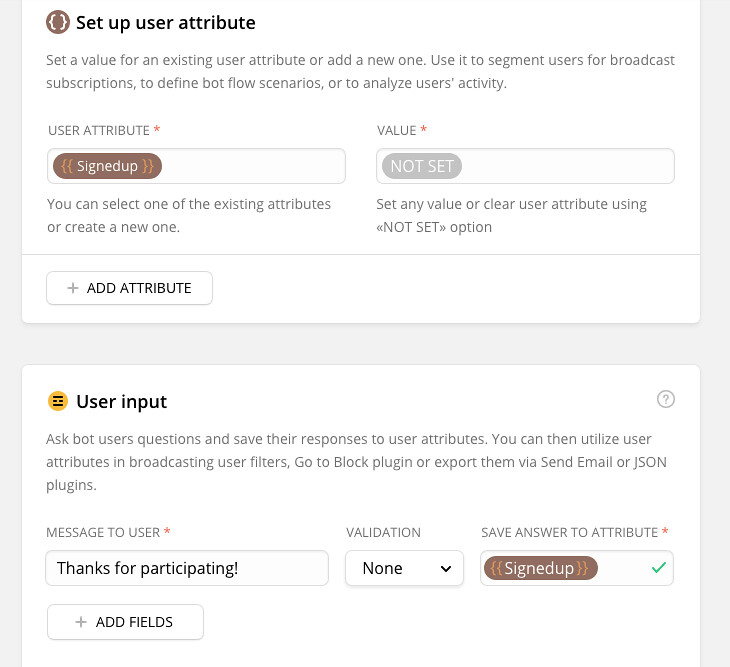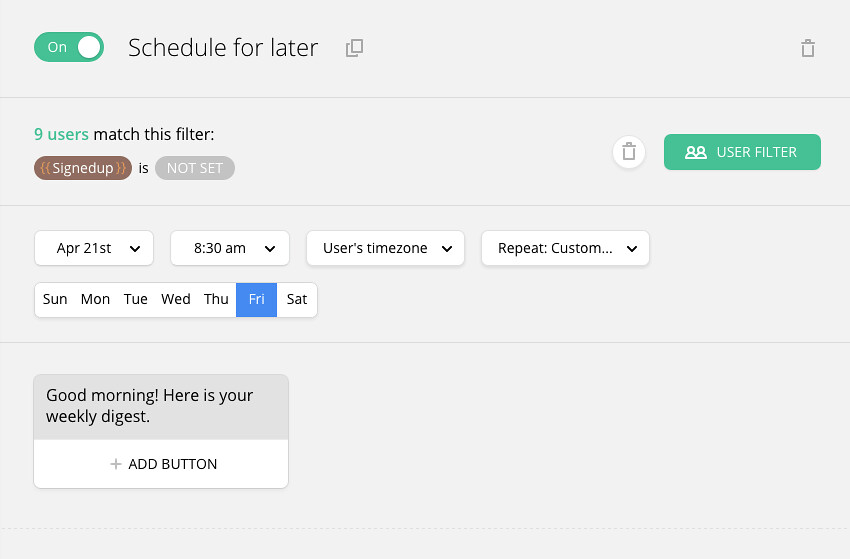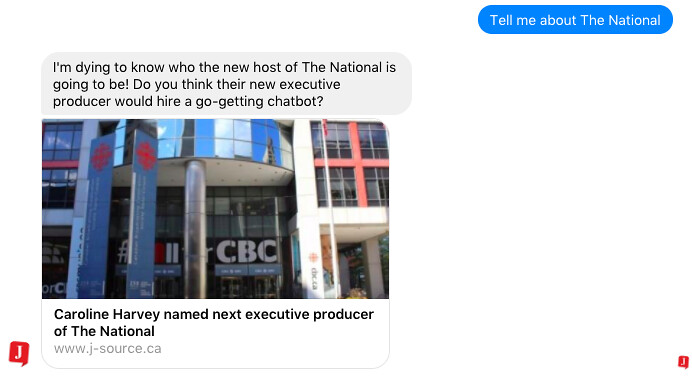With the growth of online messaging, are chatbots the next social media frontier?
By H.G. Watson, Managing Editor
A few Tuesdays ago, I tried to build my first chatbot while I watched the Blue Jays play the Red Sox. I’m not sure which experience was more frustrating.
As the Sox scored yet another run against the Jays, I glared at Chatfuel, an online bot builder that touts itself as being able to help you launch a full-featured Facebook chatbot in seven minutes.
But my attempt was stretching close to an hour. All I wanted to do was set up a simple bot for J-Source’s Facebook page that would ask new users if they wanted to sign up for a weekly digest of our top stories—essentially a Facebook version of our email newsletter. But, try as I might, I couldn’t get the program to auto-subscribe users.
Why bother working on a chatbot at all? Because the potential rewards for news organizations make them worth experimenting with. And, despite my own frustrations, it is a technology with minimum barriers to entry that anyone who has at least used a computer can try.
This story does end with a completed chatbot. So I promise, you can do this too.
Why chatbots?
My phone is not so much a phone these days as a portable computer used primarily to send messages to my friends and colleagues. “Have you seen this story/photo/video of a baby elephant trying to get into a kiddie pool?” is a fairly common refrain among my group threads on Facebook Messenger or WhatsApp or Twitter DM or, occasionally, just plain old SMS messaging.
Messaging is a major growth market. As of 2016 both WhatsApp and Facebook Messenger had surpassed one billion monthly active users. If you have a smartphone, you are using it at a bare minimum once a day. I bet if you were to check your own messages right now, you’d find that you either sent, or were sent, a link to a story or video.
There are a growing number of media outlets who see the potential for audience growth here. Take, for example, Quartz’s app which sends you the news as if it’s just a pal texting you. It isn’t. It is all automated through a chatbot. The designers of the app told Wired that they thought messaging is an “underutilized interface.”
The Globe and Mail first started experimenting with chatbots during the Canadian federal election in 2015. Last year, it built two—GloBot, which sent users daily news briefs about the U.S. presidential election, and Globe Elf, an advent calendar bot that sent users a daily “treat” over Facebook Messenger.
Shannon Busta, distributed and emerging platform strategist at the Globe, says that both bots presented an interesting challenge for the newspaper. Within a limited timeframe, they could test the bots and get back data to inform whatever they decided to do next.
One of the driving pushes was how they could better use their evergreen content—recipes, decorating suggestions, party planning tips and the like. “That’s something that I think a lot of news organizations are trying to figure out,” Busta says. One of the loose inspirations was The Guardian’s Sous Chef chatbot, which suggests recipes for you by drawing on The Guardian’s extensive food archives.
It also helps that it doesn’t require an extensive knowledge of any coding language to get started.
You can make a bot too
Busta has no background in computer coding. “The notion of building basically anything in a tech space—because it can be a space filled with jargon—it feels a bit inaccessible at times,” she said. But apps like Chatfuel don’t require you to learn any coding. The program is visually based, and relies upon a “If this, then that” system. If you type, “hello,” the AI should trigger a response.
If this is so easy, why was I grinding my teeth with anxiety as I tried to get my chatbot to respond to a simple command?
Like many technical tools, the first step is simply to play with them until you get a better sense of how they work. (Since I used Chatfuel, I’ll explain how I built my bot using its system, but I think the basic ideas would apply for the most part to other chatbot builders).
While you don’t have to know JavaScript or even HTML to do this, I do think you need to understand some basic principles of coding to understand Chatfuel. Actions are triggered in a chain, which means you need to order things sequentially.
In my case, I wanted to set my bot up so it would greet users, and then ask them if they wanted to sign up for a weekly digest of news from J-Source. That meant I had to set what Chatfuel calls a block to welcome people (this is a default on most Chatfuel templates).
Getting the yes or no answer was initially a bit more tricky. Busta notes she had to think about things visually, and I think that is helpful when thinking about chatbot. Here’s a very rough map I made to help guide me.
The key was creating a user input that would allow people to sign up. Chatfuel used plugins to guide where you go next. Here, I needed two plugins:
I did not get to this stage alone. Several days after my frustrating first attempt, Busta met me at a downtown Toronto coffee shop and we both poked away at my laptop, trying to get the chatbot to respond and add us to a list. This is perhaps my biggest piece of advice in trying to build any piece of technology: find someone who has done it before, and ask them for help. Funnily enough, Busta hadn’t realized we needed these user inputs either—the app had been updated since she had programmed Globe Elf. But having someone to brainstorm with was far more productive than sitting at home and feeling incredibly stupid.
And once you do get the hang of it, everything else comes very simply. It was an easy step to set up our breaking news notification lists. To send a digest is as simple as scheduling it—you just need the list you originally set up.
The artificial intelligence is where you get to be the most creative. For example, I programmed one of our AI prompts to send users a recent memo we published if they search anything related to CBC or The National. Here is what happens:
It is not perfect. Once when I typed CBC lower case it had trouble finding the response. Asking it questions in a more conversational tone tended to trip it up. A person who tested the bot got two very different responses from almost the same input. But I think these are things I can fix if I keep playing with the bot.
What next?
Bots are fun–once I got the hang of it, I really enjoyed getting to program all of the AI prompts. I think that may be part of the increased interest in them right now.
But I can’t help but wonder whether chatbots have a real future, or if they are just the latest in a long line of tech fads media organizations have embraced.
Busta thinks that news media organizations are still figuring that out as an industry. “The things that are challenging about bots is that people, when they’re engaging with a bot, they often want to stay in that platform,” she says. “I think for a lot of publications that just complicates the nature of bots. If they’re not really great for referral, then how do we find value them?”
That said, some of the biggest news organizations in the world have been able to use bots to successfully reach out to audiences that may not have found them otherwise. CNN’s senior vice president and chief product officer Alex Wellen told The Drum they’ve used a “choose your own adventure” style bot on Kik messenger to reach 13-17 year old users—not a typical audience for a legacy media organization.
And with the barrier to entry being low, it’s worth trying. These days, throw any new model at the wall, and see if sticks.
Even I was able to do it. You can try our new chatbot on our Facebook page right now—just send a message to us, and you’ll meet J-Bot.
H.G. Watson can be reached at hgwatson@j-source.ca or on Twitter.
H.G. Watson was J-Source's managing editor from 2015 to 2018. She is a journalist based in Toronto. You can learn more about her at hgwatson.com.

